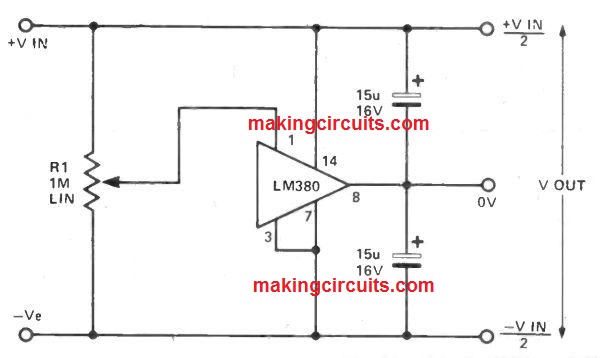The article explains how to make a simple dual power supply circuit without using a center tap transformer rather any ordinary two wire transformer.
This circuit is of interest not merely because it uses a bell transformer with a single secondary winding to provide symmetrical voltages for low-current applications but also because the final output voltages are greater than the normal bell transformer (220 V/8 V) output. In fact the final output can be as much as twice this value.
This multiplication is achieved using two voltage doublers each consisting of two diodes and two capacitors, connected head to tail.
Each diode/capacitor couple takes every alternate half cycle of the sinusoidal voltage such that the output voltage U is (theoretically) equal to 2V2 Ueff where Ueff is the effective output voltage of the transformer.
A current of 150 . . . 200 mA and 1 V of ripple can be expected using the capacitor values shown here. ln order to increase this current without a similar increase in ripple the values of the capacitors may be made greater but C1 must be approximately the same as C2, and C3 about the same as C4.
To get a stable symmetrical output of 15 V two voltage regulators, a 7815 and a 7915, should be used. This enhanced simple dual power supply circuit will then allow any two wire transformer to be used for any small circuits with operational amplifiers requiring a symmetrical supply of 14 or 15 V and a current of 0.1 .. . 0.2 A.

Simple Dual Power Supply Circuit
This simple dual power supply circuit is designed with a affordable and easy technique of acquiring a split power supply (for op amps etc.), employing the quasi complementary output stage of the famous LM380 audio power IC.

The IC has an in-built biasing so that without any input the output is placed mid way relating to the supply lines.
R1, which needs to be at first fixed at mid travel, is utilized to nullify any sort of asymmetry within the output.
Vout regulation is dependent on the circuit connecting the LM380, however the positive and negative outputs will track correctly despite of input regulation and uneven loads.
The free air dissipation is a slight above 1 watt, and thus excess cooling could be needed.
The simple dual power supply circuit device is completely secured and can get into over temperature shut down if its rated dissipation is surpassed, current restricting arises if the output current is higher than 1A3.
The input voltage must not go beyond 20 V.
If doubling the voltage is not desired (or even problematic), I believe one could use two bridge rectifiers “back to back”- one with the (-) to common, and the other with the + to common, taking + and (-) voltage outputs.
thanks for the feedback, appreciate it